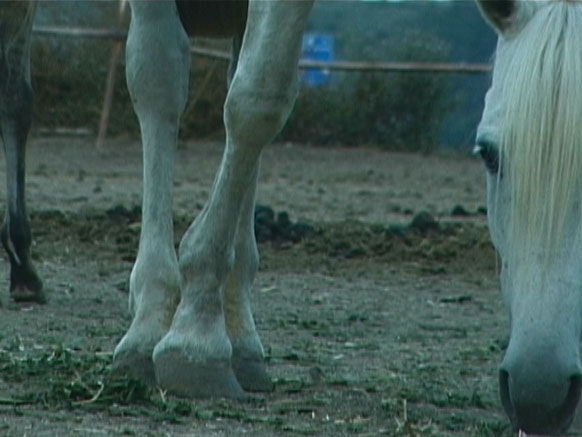JOAN ILL
ITERARE
Barcelona, 2004
Uso del territorio, consumo y ocupación
Descripción técnica:
Un travelling que transporta un proyector, recorrerá el espacio en toda su longitud (57m.) yendo y viniendo a velocidad lenta, como de caminar pausadamente, de paseo, proyectando a gran formato imágenes (patas y cabezas de caballos pisando y comiendo). El espacio expositivo quedará así dividido en dos en sentido longitudinal, con una parte delante y la otra detrás de la pantalla. La parte de delante, por la que circulará el público, será de 5 metros de ancho por 57 de largo. En la parte de atrás es donde estará instalado el travelling con el proyector, que proyectará las imágenes recorriendo longitudinalmente y a ritmo de paseo el espacio. La pantalla, de 4,30 metros de altura por 57 metros de largo y translúcida, dejará pasar las imágenes encuadradas (4,30X6m) dejando ver por transparencia el funcionamiento del proyector instalado sobre el travelling. Esta proyección, que recorrerá de un extremo a otro los 57 metros de largo del Tinglado, irá y vendrá de forma reiterativa durante tres minutos, aproximadamente, para volver a empezar.
Sentido del proyecto:
Esta instalación pretende hacer reflexionar al espectador sobre dos ámbitos que apreciamos cotidianamente: el de los seres vivos y el del territorio, que nos es soporte y que también se mueve y nos condiciona implacablemente. Importa aquí la interacción entre los dos y la sostenibilidad del ciclo natural: el desplazamiento (movimiento de patas) y bocas comiendo hierba, que vuelve a crecer abonada por los excrementos; por ello se evitan en todo momento las imágenes bucólicas de los animales enteros inmersos en el paisaje.
Pero la intención expresiva del autor no se limita a esto. Con la misma intensidad, le interesa la confrontación de este mundo de sugerencias virtuales, de mensajes y significados, con el montaje en sí en tanto que realidad perceptible: el sonido vinculado al paisaje virtual frente al ruido del motor del travelling, el desplazamiento que se proyecta frente al desplazamiento físico del aparato y del espectador... En definitiva, la reflexión consciente en torno al diálogo que se establece, sin intervención expresa de voluntad alguna, entre los dos ámbitos que, al fin y al cabo, representan la forma y el contenido: la realidad, en este caso tecnológica, y la virtualidad que ella misma es capaz de generar.
Ésta es una de las constantes en las inquietudes de Joan Ill, que quiere hacer evidente lo evidente, equiparar el valor de presencia al de “representación”. Así, de nuevo, este artista reivindica aquí tanto la materia como la tramoya de la obra, y por ello la presenta de manera explícita, sin ninguna intención de ocultación y sin dejar que pase inadvertidamente, sino transformándola en parte determinante de la obra misma.
Raquel Medina
Art Critic AICA
Use of the territory, consumption and occupation
Technical description:
A dolly with a projector mounted on it will travel the entire length of the space (57 m), slowly coming and going at the pace of someone walking or strolling, and project large-format images (hooves and heads of horses, walking and eating). The exhibition space will thus be split in two longitudinally, with one part in front of and the other behind the screen. The part in front, in which the public will circulate, will be 5 metres deep by 57 metres long. The dolly with the projector mounted on it will be installed behind the screen, where it will project the images as it moves longitudinally at a walking pace. The translucent screen, 4.30 metres high by 57 metres long, will let through the framed images (4.30 x 6 m), its transparency allowing the operation of the projector mounted on the dolly to be seen. This projection, which will travel from one end to the other of the 57-metre long Warehouse, will come and go in a reiterative way for approximately three minutes before starting over again.
Meaning of the project:
This installation aims to make the spectator reflect on two areas that we are aware of on a daily basis: that of living beings and that of the territory, which is our support and also moves and conditions us inescapably. What matters here is the interaction between the two and the sustainability of the natural cycle: the displacement (movement of hooves) and the mouths eating grass, which grows back again, fertilized by their dung; for this reason we are never shown bucolic images of the whole animals in the landscape.
But the artist’s expressive intention is not confined to this. He takes just as intense an interest in the confrontation of this world of virtual suggestions, of messages and signifieds, with the montage in itself as a perceptible reality: the sound linked to the virtual landscape in contrast to the noise of the dolly’s motor, the projected displacement in contrast to the physical displacement of the apparatus and the spectator… In short, the conscious reflection around the dialogue that is established, with no express intervention of the will, between the two areas that, in the last analysis, represent form and content: reality, in this case technological, and the virtuality that this is capable of generating.
This is one of the constants among Joan Ill’s concerns, the desire to make apparent the apparent, to equate the value of presence to that of ‘representation’. Thus once again the artist affirms here both the material and the mechanism of the work, and with this in mind presents it explicitly, and far from concealing or letting anything go unnoticed, transforming it into a determinant part of the work itself.
Raquel Medina
Art Critic AICA









"Iterare", 2004